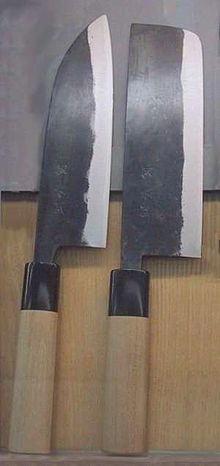Nakiri bōchō
Nakiri bōchō ( Japanese 菜 切 り 包 丁 , German “vegetable cutting kitchen knife”) and Usuba bōchō ( 薄刃 包 丁 , German “thin-cutting kitchen knife”) are Japanese- style vegetable knives . They differ from the Deba bōchō in the strength of the blade as well as in the shape of the cutting edge, which is beveled on one side from the right to enable fine, straight cuts. While the stronger and heavier blades of the Deba bōchō are not damaged by thin bones, they are unsuitable for cutting vegetables, as the thick blade would break thin vegetable slices due to the larger cutting angle. The thinner blades of the Nakiri bōchō and Usuba bōchō are better suited for cutting vegetables, but more sensitive (see cleaver ).
Hand -forged Nakiri bōchō sometimes still have a partially black blade, the so-called forged skin. The shape of the Nakiri bōchō depends on the region of origin; Knives from the Tokyo area are rectangular, whereas knives from the Osaka area have a rounded front top edge. The cutting edge is ground on both sides ( called ryoba in Japanese ), which enables more universal use.
Usuba bōchō, on the other hand, are professionally used paring knives. They differ from the Nakiri bōchō by the one-sided bevel of the cutting edge ( called katakiriba in Japanese ). This makes finer cuts possible, but requires more practice. This bevel from the right makes left-handed cutting impossible, which is why knives for left-handed people have recently been made in Japan. In addition, the usuba bōchō are usually a little heavier than the nakiri bōchō , although lighter than the deba bōchō .


